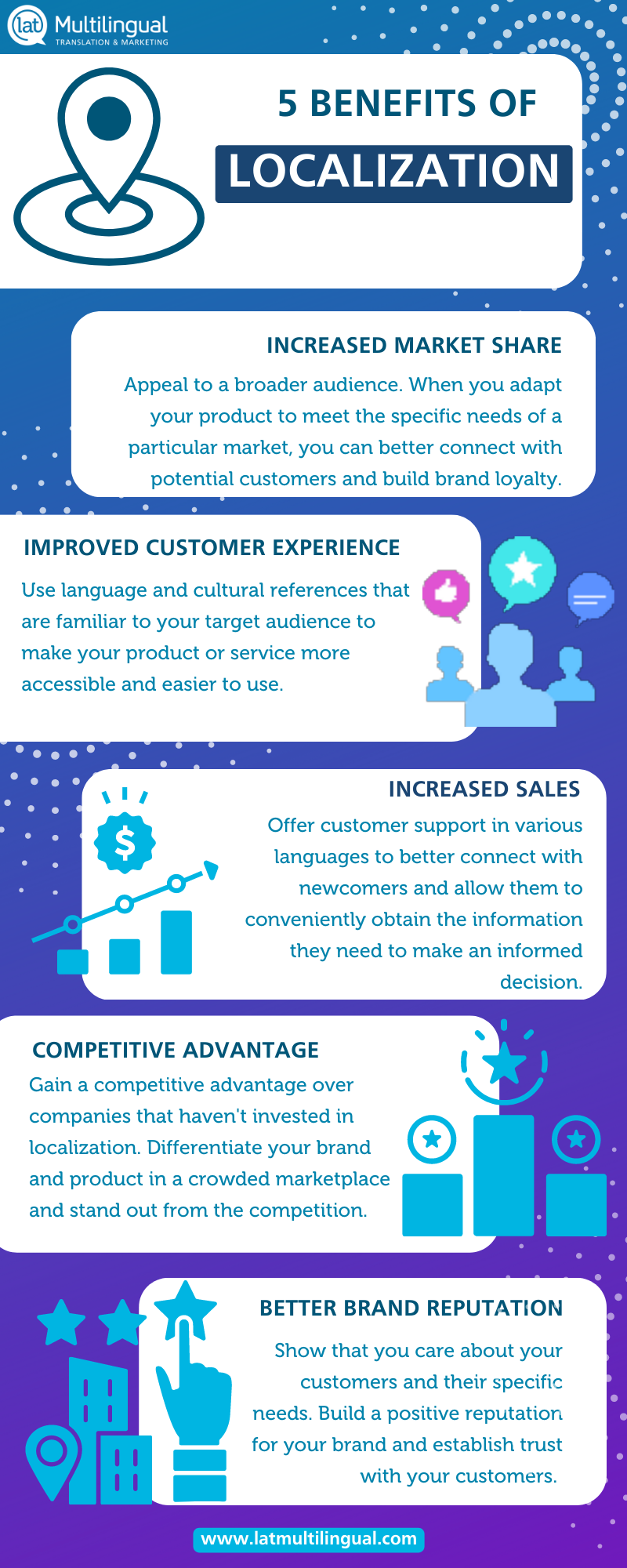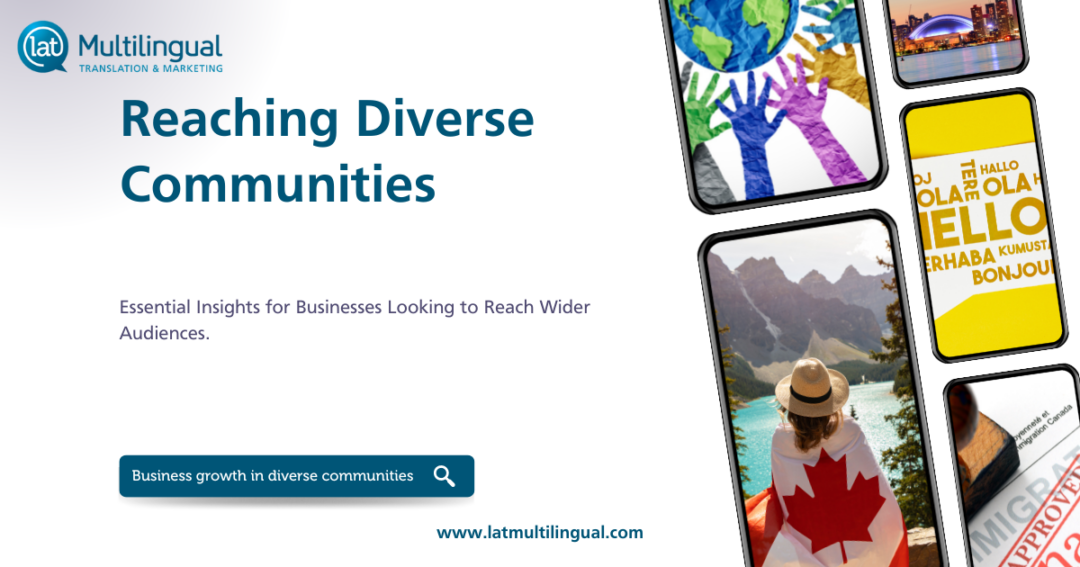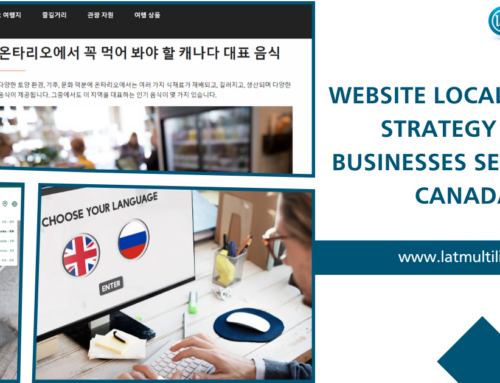As a business owner or marketer, have you considered the potential opportunity that exists in adapting your strategy and content beyond Canada’s official languages? With over 22% of the population speaking a language other than English or French at home, ignoring these diverse communities could mean missing out on a substantial customer base.
At LAT, we recognize the importance of reaching deeper into all of Canada’s communities, especially during challenging economic times.
In this blog post, we will explore the various cultures and languages in Canada and provide practical insights on how businesses can reach out to these communities effectively.
We’ll also delve into the significant impact of multicultural consumers on the economy and why it matters for businesses to tap into this diverse market.
Get ready to discover how your business can expand its customer base with a well-thought-out multilingual and multicultural marketing strategy!
Challenges and Opportunities in Reaching Diverse Communities for Business Growth
As Canada’s population keeps growing through immigration and becomes more diverse, marketers must recognize the varying needs and preferences of consumers. By understanding how different communities interpret information and what influences their decision-making, you can develop messaging and promotions that resonate with them.
Creating targeted campaigns will allow you to engage and connect with more consumers.
Language is another critical factor to consider while engaging with diverse communities. While some may have a good understanding of English or French, many still prefer communication in their mother tongue. You must also determine which specific demographic you want to reach and whether a broad category such as South Asian or Latin American consumers is sufficient or if more specific targeting is necessary.
The increasing diversity of Canada’s population extends beyond the traditional markets of Toronto, Vancouver, and Montreal. Attention needs to be given to other urban areas with growing immigrant populations.
The growing number of temporary residents in Canada such as international students and workers are also shopping for products and services while in the country.
Key takeaways and opportunities:
Develop effective messaging and promotional campaigns that resonate with multicultural communities and consider factors such as language and sub-population targeting.
- Understand the diverse needs and preferences of diverse communities.
- Consider language as a critical factor in reaching multicultural communities.
- Pay attention to other urban areas with growing immigrant populations and recognize the growing number of temporary residents in Canada.
Language Adaptation for First-Generation Immigrants
Arriving in a brand-new country and starting a new life can be a daunting experience, especially for first-generation immigrants who are still adapting to their new surroundings. For many of these individuals, language can be a significant barrier to building confidence and feeling included in Canadian society.
Understand the importance of language adaptation and localization to connect with these communities.
For instance, over 1.7 million people in Canada are of Chinese origin. Many are still adapting to their new home and language can be a difficult barrier. Providing multilingual support & marketing on their favourite social platforms, such as WeChat, RED, or Weibo and product information tailored to them will help you become a trusted resource for their needs.
While English and French are still the main languages spoken in Canada the country’s linguistic diversity continues to grow. The 2021 Census found that 4.6 million Canadians speak a language other than English or French at home – Tagalog, Mandarin and Punjabi being the most common. This percentage equates to 12.7% of the population!
Multilingual support and tailored marketing messages help businesses create a sense of inclusion and build brand loyalty within Canada’s diverse communities.
For instance, many Asian communities celebrate the Lunar New Year. Acknowledge and celebrate this holiday to convey that you value and respect their cultural heritage. Similarly, you can show support for Pride Month for the LGBTQ2S+ community.
Keep in mind that although some communities might seem to share the same cultural background, there are differences that we need to be sensitive to. For instance, South Asian communities can be of Indian, Pakistani, or Sri Lankan origin. Take the time to research and understand the nuances of each community you aim to reach.
Key takeaways and opportunities:
- Acknowledge and appreciate cultural differences among multicultural communities.
- Develop effective and respectful communication strategies.
- Celebrate cultural holidays and events to demonstrate respect and support.
- Research and understand the nuances of each community to reach them effectively.
How Diverse Consumers are Powering the Canadian Economy
According to a study by the Conference Board of Canada, multicultural consumers are projected to represent 33% of the Canadian population by 2031. They will account for $1.7 trillion in purchasing power. That’s a massive market that businesses cannot afford to ignore.
Chinese Canadians, Indo-Canadians, and Filipino Canadians are some of the largest and fastest-growing cultural groups in Canada, with significant purchasing power. For example, Chinese Canadians have an estimated purchasing power of over $44 billion annually, making them a highly sought-after market.
Similarly, Indo-Canadians have a purchasing power of over $35 billion, while Filipino Canadians have a purchasing power of $15 billion.
Multicultural consumers are a large market and are also highly engaged consumers who prioritize brands that cater to their cultural needs. Studies show that:
72% of multicultural consumers prefer brands that demonstrate an understanding of their cultural background.
71% of them are willing to pay more for products that reflect their cultural identity.
To truly connect with multicultural consumers, go beyond superficial attempts and invest in meaningful engagement that demonstrates a genuine understanding of the community’s needs and values.
Key takeaways and opportunities:
- Tailor your marketing strategy to the customer journey: Consumers have different cultural preferences and behaviours. For newcomers, recommendations from friends and family or trusted community members are crucial. Some prefer to shop in-store rather than online. Tailoring your marketing strategy to their preferences can help you optimize your outreach.
- Use storytelling to build emotional connections: Storytelling can be a powerful tool for building connections. Consider highlighting stories of specific community members who have benefited from your products or services, or sharing your own story of how your business came to understand and appreciate the cultural preferences of your customers.
How to Build Brand Loyalty with New Immigrants
Canada’s ambitious immigration targets present a significant opportunity for businesses.
400,000 new immigrants are expected to arrive annually by 2023.
Businesses that cater to the unique needs and preferences of newcomers have a chance to build brand loyalty from the start.
Here are some tips on how your business can best succeed in capturing the hearts and minds of new demographics:
1. Provide a positive customer experience.
This includes hiring staff who speak the language of the target community, offering products that cater to their preferences, and providing a welcoming and inclusive environment that is sensitive to cultural differences.
2. Adapt marketing messages and product offerings.
Create targeted marketing campaigns that speak to the values and interests of these communities. This can help them feel seen, heard, and understood, which is essential for building brand loyalty.
3. Build relationships with key opinion leaders (KOLs).
KOLs within immigrant and diverse communities help brands bridge the cultural gap and better understand people’s needs and preferences. KOLs can also help businesses earn trust, which is essential for building brand loyalty.
Key takeaways and opportunities:
- New immigrants provide a fast-growing consumer base that businesses must reach with well-adapted marketing strategies.
- Understanding the cultural nuances and preferences of new immigrants is crucial for building brand loyalty.
- Building a diverse and inclusive workplace and customer experience can help new immigrants feel valued, leading to positive word-of-mouth referrals.
- Working with influencers and leveraging the right social media platforms can increase brand visibility and reach among new immigrants.
Housing – a Priority for Newcomers to Canada
Newcomers to Canada prioritize housing as one of their top concerns. The real estate industry can establish brand loyalty by providing targeted, multilingual marketing for property listings and rental agreements.
Chinese homebuyers accounted for nearly one-third of Vancouver’s real estate market in 2015, according to a study by the National Bank of Canada.
While newcomers from India are among the most represented in the highly educated demographics, they are known to prioritize home ownership. Owning a home is seen as vital to South Asians. The Real Estate industry is well aware of this and often caters to their unique needs and preferences, especially in cities like Toronto, Vancouver, Calgary, and Edmonton.
Key takeaways and opportunities:
- There is a significant market for the real estate industry among newcomers from China and India, two of the largest immigrant groups in Canada.
- By understanding the cultural differences and preferences of different immigrant groups, real estate businesses must create marketing campaigns that speak to their values and interests, and build brand loyalty.
- Real Estate companies should offer additional services such as assistance with paperwork and legal requirements, thus establishing themselves as a trusted and reliable partner for newcomers to Canada.
Localizing your content helps increase sales, build brand loyalty, and improve your reputation. Check out this infographic on the benefits of localization to learn more about how it can help your business thrive in diverse markets.

Reaching Diverse Communities: Opportunities in Food & Beverages, Fashion, Health & Beauty, and More…
Businesses in all industries can benefit from adopting a multilingual approach and offering services in various languages.
In the food industry, global cuisine has become increasingly popular among Canadians. People often celebrate diversity through food, music and cultural festivals. With the growing number of new immigrants coming to Canada, the demand for a wide variety of foods will continue to grow.
As a retailer, start considering the taste palates, dietary restrictions, and sensitivities of the new demographic mix.
Nature’s Emporium and Longo’s are among the retailers catering to diverse populations and Canadians who are open to trying new-to-them foods. They offer private-label lines of organic spices, seasonings, and marinades inspired by cultures from around the world.
Consumers are also interested in cooking different global cuisines at home. Companies like Shivani’s Kitchen and Lola’s Food offer ready-to-eat meals that are affordable, convenient, and packed with authentic flavours. T&T and McCormick have also capitalized on the trend of consumers cooking global cuisines at home by offering a variety of authentic international flavours in their products.
Key takeaways and opportunities:
- Businesses in the fashion industry are increasingly catering to multicultural consumers by adapting their marketing to reach people in their own language.
- To increase brand visibility among specific communities, sponsoring cultural events or festivals, such as Diwali or Lunar New Year celebrations will showcase your support and commitment to diversity.
- All industries can benefit from offering language adaptation of product descriptions, customer service, and online and offline content to better serve multicultural clients and build trust with them.
Connecting Newcomers to Canada’s Natural Environment
As newcomers adjust to their new surroundings, they may feel disconnected from nature, impacting their mental and physical health. Businesses can play a crucial role in helping new immigrants connect with nature and feel more at home in their new environment.
One way that travel and tourism businesses can support newcomers is by offering outdoor education programs. These programs can teach newcomers about Canada’s natural environment and the different outdoor activities available to them. They can also help newcomers learn about outdoor safety and etiquette, which can help them feel more confident when exploring Canada’s wilderness.
By offering these programs, tourism businesses can help newcomers feel more connected to nature and develop a sense of belonging in their new community.
Cultural tours are also an excellent way to connect newcomers to Canada’s natural environment. These tours can provide people with insight into the cultural significance of Canada’s natural landmarks and help them understand the importance of preserving these places for future generations.
Cultural tours can also help immigrants learn about the history and traditions of Canada’s Indigenous peoples, who have a deep connection to the land.
Key takeaways and opportunities:
- Language support services, such as translation or interpretation, can help tourism businesses connect with newcomers who may not speak English or French fluently and make them feel more comfortable participating in outdoor activities.
- Tailor outdoor education programs to specific cultural groups, such as offering snowshoeing or ice-fishing for newcomers. These experiences will broaden their experience of Canada and make them appreciate all it has to offer – even its coldest season!
- Collaborate with local schools or community organizations to offer outdoor education programs for children and youth. Aside from helping them make new friends, this will build a sense of connection to their new environment.
- Provide newcomers with resources and information in different languages about local parks, nature reserves, and hiking trails. This can help them feel more comfortable exploring the natural environment on their own.
Leveraging Word of Mouth and Key Opinion Leaders (KOLs) for Reaching Diverse Communities
Immigrant communities are often tight-knit and rely heavily on recommendations from their own network when making purchasing decisions. Businesses that cater to the needs of these communities can leverage word-of-mouth marketing to build trust and brand loyalty. Positive experiences shared by members of their own community will go a long way.
Key Opinion Leaders (KOLs) are individuals who have a significant following within their community and whose opinions are highly valued. Partnering with KOLs and setting up influencer marketing campaigns is a great way to reach specific communities.
In addition to leveraging word-of-mouth marketing and KOLs, connect with communities by participating in events, supporting local organizations, and building relationships with community leaders.
Key takeaways and opportunities:
- Offer incentives for customers to refer their friends and family to the business. For example, a discount on their next purchase or a free product can motivate customers to spread the word about their positive experiences with the business.
- Utilize community-driven platforms and social media channels for reaching multicultural communities. For instance, local community Facebook groups, WhatsApp groups, or WeChat and RED groups are often active channels for discussions and recommendations.
Here’s how Vancouver International Airport engages with the Chinese community on their preferred social media channels.
Examples of Brands Reaching Diverse Communities
Telus has done an excellent job of reaching various communities in Canada. The telecommunication giant recognizes the importance of WeChat to reach Chinese residents. Telus provides information and customer service in Chinese, which helps them connect with this community in a more meaningful way.
Another example is Scotiabank. Their StartRight program for newcomers was a peer-to-peer campaign that aimed to connect with Canada’s diverse communities. The “First Day” campaign captured real financial and life advice from newcomers. By highlighting these stories and experiences, Scotiabank established itself as a brand that understands the needs of diverse communities and is committed to supporting them.
Final thoughts
As more immigrants come to Canada and the country becomes even more diverse, businesses that invest in multicultural marketing will be better positioned for long-term success.
Businesses can benefit greatly from adapting to the needs of newcomers and second-generation immigrants in Canada. By providing multilingual options and cultural adaptation, businesses can build brand loyalty from the start and grow their revenue by tapping into the purchasing power of these growing communities.
Being proactive in catering to newcomers allows businesses to position themselves as a resource that will benefit both the brand and the customers it aims to serve.
Don’t miss out on the opportunity to connect with Canada’s newest residents and build lasting relationships with this growing customer base. Our team of experts can help you develop and implement a well-adapted marketing strategy to ensure your business succeeds in today’s increasingly diverse marketplace. Get in touch!













